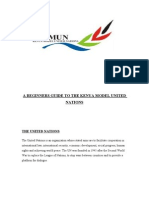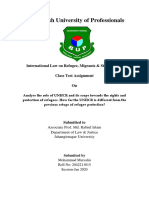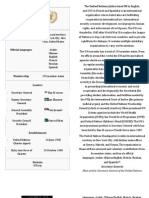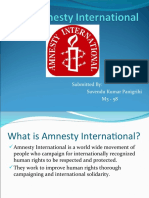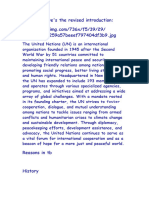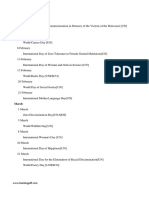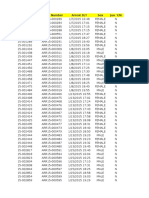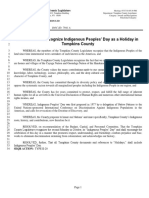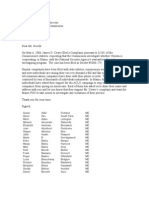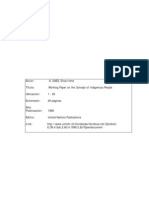United Nations High Commissioner For Refugees (UNHCR)
United Nations High Commissioner For Refugees (UNHCR)
Uploaded by
hridoyaf38Copyright:
Available Formats
United Nations High Commissioner For Refugees (UNHCR)
United Nations High Commissioner For Refugees (UNHCR)
Uploaded by
hridoyaf38Original Title
Copyright
Available Formats
Share this document
Did you find this document useful?
Is this content inappropriate?
Copyright:
Available Formats
United Nations High Commissioner For Refugees (UNHCR)
United Nations High Commissioner For Refugees (UNHCR)
Uploaded by
hridoyaf38Copyright:
Available Formats
United Nations High Commissioner for Refugees
UNHCR was established by a UN General Assembly’s resolution called the Statute of the Office
of the High Commissioner for Refugees, adopted on 14 December, 1950. It began its operation
on 1 January, 1951. Its mandate is to provide, on a non-political and humanitarian basis,
international protection to refugees and to seek permanent solutions for them.
Status
UNHCR is a subsidiary organ of the UN General Assembly and will discharge its duties under
the guidance of the General Assembly and ECOSOC of United Nations. All important issues
including policy are considered by the Executive Committee of High Commissioner’s Program.
The members of the Committee are almost permanent.
Appointment and term of office
UNHCR is appointed by the UN Secretary General after approval of the UN General Assembly.
The Office was originally established for a period of three years. Thereafter it was extended for
successive periods of five years subject to be reappointed for one further time.
Functions
the Statute of the Office of the High Commissioner for Refugees lists nine specific activities
which are:
---to promote the conclusions and ratification of international conventions, supervising their
application and proposing amendments
---to promote measures to improve the situation of refugees and reduce the number requiring
protection
--- to assist efforts to promote voluntary repatriation or local settlement
---to promote admission of refugees to the territories of states
---to facilitate the transfer of refugees’ assets
--- to obtain from Governments information concerning refugee numbers and conditions,
relevant laws and regulations
--- to keep in touch of Governments and inter-governmental organizations
--- to establish contact with private organizations
--- to facilitate the coordination of other organization’s efforts
Principal Mandate of UNHCR
UNHCR has two basic functions, namely—
---to provide international protection for refugees
---to seek durable solutions to their problems
These durable solutions fall into the following three categories:
1) Voluntary Repatriation--- this covers preparations for departure to the country of origin,
transportation etc. It also involves activities in the country of origin, including organizing
reception facilities and assistance during the initial phase of reintegration.
2) Local settlement assistance--- this covers activities in providing assistance to refugees who
cannot return home. It aims to promote their self- sufficiency and local integration.
3) Resettlement---UNHCR facilitates permanent resettlement in third countries through securing
resettlement places, medical screening, arranging for travel and measures to facilitate the
integration o9f the refugees in the country of resettlement.
You might also like
- Fib - 07 - Corrugated Plastic Ducts For Internal Bonded Post-Tensioning - NMGDocument53 pagesFib - 07 - Corrugated Plastic Ducts For Internal Bonded Post-Tensioning - NMGer.wasimqadir7654No ratings yet
- Tbilisi Pride Submission To ECRIDocument8 pagesTbilisi Pride Submission To ECRITbilisi PrideNo ratings yet
- A Beginners Guide To KmunDocument35 pagesA Beginners Guide To KmunAngela KagunyiNo ratings yet
- Campus MapDocument1 pageCampus Mapapi-234427091No ratings yet
- Canadian Family Law CasesDocument3 pagesCanadian Family Law CasesgenNo ratings yet
- Role of UNHCR in Protection of RefugeesDocument4 pagesRole of UNHCR in Protection of RefugeesApurva AmbasthNo ratings yet
- Analyse The Role of UNHCR PDFDocument6 pagesAnalyse The Role of UNHCR PDFMursalin MohammadNo ratings yet
- United Nations SuccessDocument4 pagesUnited Nations Successanin_boboNo ratings yet
- IE University Virtual MUN 2020Document27 pagesIE University Virtual MUN 2020CarolinaVillegasNo ratings yet
- Office of UNHCR Structure and FunctionsDocument47 pagesOffice of UNHCR Structure and Functionsmidlaj keepayurNo ratings yet
- United Nation: State Philosophy and Citizenship GABRIEL PUTRA P. - 001201600043Document11 pagesUnited Nation: State Philosophy and Citizenship GABRIEL PUTRA P. - 001201600043dika franNo ratings yet
- HCR BG 2024Document10 pagesHCR BG 2024SamairaNo ratings yet
- Durable SolutionDocument23 pagesDurable SolutionSheikh vlogsNo ratings yet
- University Institute of Legal Studies, Panjab University, ChandigarhDocument9 pagesUniversity Institute of Legal Studies, Panjab University, ChandigarhNavraj DhaliwalNo ratings yet
- The Comprehensive Refugee Response Framework (CRRF) : Manirujjaman ManirDocument9 pagesThe Comprehensive Refugee Response Framework (CRRF) : Manirujjaman Manirshis gtcNo ratings yet
- Contemporary World Lesson 3Document40 pagesContemporary World Lesson 3WENDELL VERGARANo ratings yet
- From The Desk of Committee Director MUNIC-2012Document9 pagesFrom The Desk of Committee Director MUNIC-2012Ruhaan AhmedNo ratings yet
- P.T.'s Roll No. 291 Class: VII Subject: Social Studies Topic: Union Nation OrganizationDocument13 pagesP.T.'s Roll No. 291 Class: VII Subject: Social Studies Topic: Union Nation Organizationtonys0181No ratings yet
- United Nation and Org.Document14 pagesUnited Nation and Org.olisha joshuaNo ratings yet
- International Organisations Notes (Punjab Combined Course)Document104 pagesInternational Organisations Notes (Punjab Combined Course)Legal VictorNo ratings yet
- Internantional Organisation and Peace ResolutionDocument19 pagesInternantional Organisation and Peace ResolutionFernandez IlobaNo ratings yet
- Lesson 4: Contemporary Global GovernanceDocument20 pagesLesson 4: Contemporary Global GovernanceMary Rose NaboaNo ratings yet
- 5 The United NationsDocument50 pages5 The United NationsThea Shaine B. SILARDENo ratings yet
- Refugee Protection Under The Constitution of Bangladesh: A Brief OverviewDocument16 pagesRefugee Protection Under The Constitution of Bangladesh: A Brief Overviewistiakamd46No ratings yet
- UN and ITIDocument4 pagesUN and ITISneha YadavNo ratings yet
- 6 The United NationsDocument50 pages6 The United NationsIris Jane N. SILVELANo ratings yet
- Main Article: Secretary-General of The United NationsDocument8 pagesMain Article: Secretary-General of The United NationsKaren LovedorialNo ratings yet
- Short Note of UNO For Students.Document11 pagesShort Note of UNO For Students.Sandeep Rs Singh100% (4)
- 4 - The UN and CGGDocument31 pages4 - The UN and CGGTrixie AgsolidNo ratings yet
- UN - Rumki BasuDocument44 pagesUN - Rumki BasuAarushi MishraNo ratings yet
- HR Enforcement Mechanism 2Document4 pagesHR Enforcement Mechanism 2Ali SialNo ratings yet
- Contemporary Week 5Document5 pagesContemporary Week 5apriljoyyorNo ratings yet
- Class_11_International_Organizations_Grouping_Agreementdocx_1690500043 (4)Document26 pagesClass_11_International_Organizations_Grouping_Agreementdocx_1690500043 (4)Kanchan YadavNo ratings yet
- Dimalen, Bai Maddeha N. 10/14/19 Bsmls-2K: 1. The United Nations (UN)Document2 pagesDimalen, Bai Maddeha N. 10/14/19 Bsmls-2K: 1. The United Nations (UN)Bai Maddeha DimalenNo ratings yet
- United NationsDocument20 pagesUnited NationsVikas ChoudharyNo ratings yet
- Un-Structure and FunctionsDocument4 pagesUn-Structure and Functionsdev.pillai20013No ratings yet
- BG - UNHCR - Rights of Internally DisplacedDocument6 pagesBG - UNHCR - Rights of Internally DisplacedLisha priyaNo ratings yet
- International OrganizationsDocument42 pagesInternational OrganizationsHeli de AlwisNo ratings yet
- The United Nations Security Council ReformsDocument3 pagesThe United Nations Security Council ReformsHafeefa SultanaNo ratings yet
- United NationsDocument11 pagesUnited NationsSHAMAPRASAD H P SDM College(Autonomous), UjireNo ratings yet
- CLJ 1 Week 5Document7 pagesCLJ 1 Week 5JOHNPAUL ASUNCIONNo ratings yet
- UN and Other OrganztionsDocument9 pagesUN and Other OrganztionsRick And MortyNo ratings yet
- UNHCR Study GuideDocument20 pagesUNHCR Study Guidezendora46No ratings yet
- Int. Political InstitutionsDocument64 pagesInt. Political InstitutionsTooba ZaidiNo ratings yet
- UN AssignmentDocument6 pagesUN AssignmentErika Judith Bivera100% (1)
- Study Guide UNHCR PDFDocument22 pagesStudy Guide UNHCR PDFMuhammad Al KautsarNo ratings yet
- LESSON 4 the United Nations and Contemporary GlobalDocument4 pagesLESSON 4 the United Nations and Contemporary Globalcarlocabizb15No ratings yet
- Submitted By: Suvendu Kumar Panigrihi M3 - 58Document13 pagesSubmitted By: Suvendu Kumar Panigrihi M3 - 58rish2811No ratings yet
- 1) Mob ViolanceDocument30 pages1) Mob ViolancesameeraklmrlNo ratings yet
- Power System-II EE-328-FDocument13 pagesPower System-II EE-328-FAjay ChaudharyNo ratings yet
- OrganizationDocument12 pagesOrganizationWaqas AzizNo ratings yet
- Global Interstate System: Assoc. Prof. Jose Ricarte B. OrigenesDocument38 pagesGlobal Interstate System: Assoc. Prof. Jose Ricarte B. OrigenesWelwel SumabatNo ratings yet
- How Did The UN Come Into Existence?Document9 pagesHow Did The UN Come Into Existence?Roxyn ZamoraNo ratings yet
- UNITED - NATIONS Upsc - 1651144006575Document13 pagesUNITED - NATIONS Upsc - 1651144006575Random PersonNo ratings yet
- Role Actors in Humanitarian System 2Document12 pagesRole Actors in Humanitarian System 2odpphomicide researchNo ratings yet
- Globalisation A3Document6 pagesGlobalisation A3Angel AngelNo ratings yet
- Important International OrganisationsDocument17 pagesImportant International Organisationsashutoshvashisth8No ratings yet
- Project 2023Document3 pagesProject 2023debdulaldamNo ratings yet
- United Nations - NotesDocument7 pagesUnited Nations - NotesAreen KumarNo ratings yet
- An Exclusive Project Report On United Nations OrganizationDocument15 pagesAn Exclusive Project Report On United Nations OrganizationDilip JaniNo ratings yet
- Misc. GK 1 Ch. 27 UN and Other Organztions Copy 2Document9 pagesMisc. GK 1 Ch. 27 UN and Other Organztions Copy 2chdeepak96No ratings yet
- The United Nations Is An International OrganizatioDocument7 pagesThe United Nations Is An International OrganizatiolatmanNo ratings yet
- Ecosoc Guide1Document7 pagesEcosoc Guide1Pepe RamirezNo ratings yet
- January: Important UN DaysDocument10 pagesJanuary: Important UN DaysksmNo ratings yet
- Human Rights and Social Work EducationDocument14 pagesHuman Rights and Social Work EducationDinh Thanh Phuong 001891No ratings yet
- Draft ResolutionDocument14 pagesDraft Resolutionarjumandahmad2010No ratings yet
- Prostitution Arrest DataDocument32 pagesProstitution Arrest DataRecordTrac - City of Oakland100% (1)
- Case AnalysisDocument2 pagesCase AnalysisHazelyn EspedidoNo ratings yet
- كتاب كتابة الحروف+ صورةDocument30 pagesكتاب كتابة الحروف+ صورةMai MansourNo ratings yet
- Fiji's People's Charter For ChangeDocument35 pagesFiji's People's Charter For Changeveenabobby100% (1)
- Case Study 2 (Unocal in Burma Case Study)Document3 pagesCase Study 2 (Unocal in Burma Case Study)Ahmad FauzanNo ratings yet
- Civil Rights Movement DBQDocument4 pagesCivil Rights Movement DBQapi-309456562No ratings yet
- Mid Term I - Extra Practice 3 WITH KEY - 1Document4 pagesMid Term I - Extra Practice 3 WITH KEY - 1Ezequiel SainzNo ratings yet
- Initial Decision by Deputy Chief of Police Itzhak HennDocument5 pagesInitial Decision by Deputy Chief of Police Itzhak HennLas Vegas Review-JournalNo ratings yet
- FoRB Annual Report 2015Document100 pagesFoRB Annual Report 2015Anonymous LP3Pyan3No ratings yet
- Indigenous Peoples' Day ResolutionDocument1 pageIndigenous Peoples' Day ResolutionKelsey O'ConnorNo ratings yet
- Verizon Wiretapping - Comments in Support of MR Cowie's ComplaintDocument8 pagesVerizon Wiretapping - Comments in Support of MR Cowie's ComplaintireportNo ratings yet
- Right To Abortion in India: Hidayatullah National Law UniversityDocument19 pagesRight To Abortion in India: Hidayatullah National Law Universityritika dhidhiNo ratings yet
- The Rule of Law in Sub-Saharan Africa - An Overview: Peter ShivuteDocument7 pagesThe Rule of Law in Sub-Saharan Africa - An Overview: Peter ShivuteVictor CantuárioNo ratings yet
- The Role of Free Press in Promoting Good GovernanceDocument5 pagesThe Role of Free Press in Promoting Good GovernanceMuhammad Majid AltafNo ratings yet
- Jurisprud II ContentsDocument6 pagesJurisprud II ContentsSanni KumarNo ratings yet
- Vinuya Vs ESDocument2 pagesVinuya Vs ESAlyanna BarreNo ratings yet
- Human Rights Law & PracticeDocument9 pagesHuman Rights Law & PracticesijithskumarNo ratings yet
- Working Paper On The Concept of Indigenous PeopleDocument27 pagesWorking Paper On The Concept of Indigenous PeopleGrupoComunidades100% (1)
- Juris Ray - Jan-2013 PDFDocument104 pagesJuris Ray - Jan-2013 PDFakash patelNo ratings yet
- GSLDocument1 pageGSLPRachi100% (1)
- DocumentDocument3 pagesDocumentgood hansNo ratings yet
- THSVK MunDocument5 pagesTHSVK MunMairaNo ratings yet
- Crayons (C)Document4 pagesCrayons (C)ungureanoanaNo ratings yet


